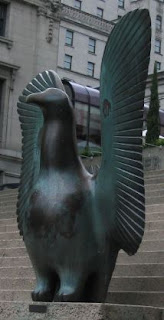This is the sixth and final post in the series. I've been to Vancouver, British Columbia several times. It was one of the first trips my wife and I took together. I remember going to a bar-restaurant called Puccini's, much like the one from the TV show Cheers. It used to be a jazz/blues club in the bar downstairs from the 60s to the late 80s. We heard that Bette Midler sang there once with backup singers, possibly even the Harlettes. If so, then it must have been very early on before her career started taking off in the 1970s.
In 1986, my brother and I went to Pacific Coliseum for a hockey game and he purchased a celebrity hockey souvenir poster. Not sure who the artist was. It had caricatures of all the original players: Richard Dean Anderson ("MacGyver"), Scott Baio ("Joanie Love Chachi" and "Charles in Charge"), Michael J. Fox ("Family Ties" and "Back to the Future" ), Jerry Houser ("Slapshot" and "The Brady Girls Get Married") and Alan Thicke ("Growing Pains"). Scott Bakula ("Quantum Leap") joined later. In my younger days, I used to do caricatures of family, friends, and co-workers, often doodling their likenesses during meetings. For some, I was even able to draw their faces from memory.
Now for art in and around the city...
Murals
Vancouver has over 50 murals in and around the city. Famous for its Mural Festival in August in the Mount Pleasant neighborhood, the city invites public art by artists of all types. Some muralists are also known as graffiti artists. This one is called, Face in the Shadows, by Linsey Levendall.
Canadian abstractionist painter and sculptor, Beatrice Lennie is responsible for some of the major public art of Vancouver. In 1949, the city commissioned her to create the mural/sculpture Wheel of Industry for the Vancouver Labour Temple.
Aside...
According to Wheel of Fortune's S33/Ep180 (which aired 20 May 2016) Great American Cities: Philadelphia, the 'City of Brotherly Love' has a Mural Arts Program that has produced over 3,800 murals. Did you know that, in honor of the 19th amendment (Women's right to vote), the city has temporarily changed its nickname to the 'City of Sisterly Love' for 2020? Although Canadian women's suffrage was granted initially in 1916 to some areas, and later only to certain demographics, it wasn't until 1960 that the full population of Canadian women got the right to vote.
 |
| Girl in Wetsuit (1972), Eles Imredy |
Sculpture
Stanley Park has a statue called, Girl in a Wetsuit, by Elek Imredy, which may be inspired by Denmark’s Little Mermaid by Edvard Eriksen. Although Eriksen's Copyright lasts thru 2029, Imredy's version has a mask, wetsuit, and rubber swim fins and is clearly not a mermaid.
A-maze-ing Laughter (2009) by Yue Minjun is a bronze sculpture located in Vancouver's Morton Park. This looks like a fun and potentially interactive photo opportunity for locals and visitors alike.
Giants on Granville Island's Ocean Cement buildings is a mural painted by Brazilian twin brothers, Gustavo and Otavio Pandolfo (a.k.a. OSGEMEOS) around six silos, creating a 3D sculpture in effect. Apparently, Vancouver is not the only city to grace similar 'Giants'.
A Dance of Death, Vancouver's Canadian Pacific Railway War Memorial (1922), was sculpted by Coeur de Lion MacCarthy to remember those fallen railway workers who died serving in World War I. Winged Victory is either the Roman Goddess Nike who protected ships during sea battles or an angel carrying off a soul to heaven. The Greek version symbolizes peace, fortune, vengeance, and justice. She also symbolizes triumph, peace, and eternal life.
NYC and London have similar sculptures of such winged angels and goddesses.
Birds
FYI, in my previous post about Helena, Montana, I tried to find baseball players who were born in Montana, and I only found two -- Washington Senator 2B Herb Plews and Minnesota Twins OF Dave Meier. This is likely because Montana and Wyoming are the only two states that don't offer baseball as a high school sport. Meier actually played high school baseball in Fresno, CA.
Paintings
Blunden Harbour is a post-impressionist oil painting created by Emily Carr (1928-30) of Victoria. It's based on a 1901 photograph of the 'Nakoaktok' Village taken by Dr. Charles F. Newcombe. It has a Cubist feel with its sharp edges and angular shapes. The Vancouver Art Museum is currently exhibiting Rapture, Rhythm, and the Tree of Life: Emily Carr and Her Female Contemporaries
through December 13, 2020.
Internationally acclaimed landscape artist, Robert Genn (1936-2014) painted all over the world although his subject matter usually involved Canada's West Coast. He published an online newsletter twice-weekly encouraging artists around the world with advice and sharing artists' quotes. He also published three books. Skeena Sky Window caught my eye with its colors and totems looking longingly at a similarly colored purple sky and mountains.
Here are two of Genn's quotes that align with the focus of this blog:
"Learning to focus and pay attention, if only for a short time,
has been identified as a primary key to the development of human effectiveness."
"Art, because it is so easy to do, and yet so difficult to do well,
encourages humility in the human soul."
I've learned quite a bit about art in the Pacific NW by doing this series. I hope you've enjoyed reading and maybe get inspired to visit these cities that are so rich in visual arts. As always, I am open to suggestions about art topics to post and I invite other bloggers to propose links to related topics.


























































